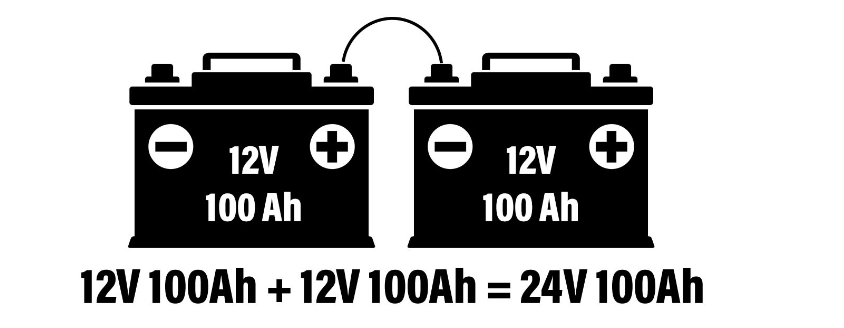Whether you have a boat, RV, solar setup, or another application, sometimes one battery isn't enough to meet your voltage or ampere capacity needs. Connecting batteries in series or parallel could be the solution. But which method is better for your specific application? In this article, we'll explore the differences between connecting batteries in series vs. parallel and help you determine which method is best for you.
Both series and parallel connections increase the total available energy, measured in watt-hours. However, they achieve this in different ways and with different results. Let's dive into the details of each method.
When you connect batteries in series, you increase the overall voltage of the system while keeping the same ampere capacity. For example, connecting two 12V 100Ah batteries in series will give you a combined voltage of 24V, but the capacity remains at 100Ah.
Here's how to connect batteries in series:
Important: Ensure all batteries have the same voltage and capacity rating before connecting them in series. Mixing different batteries can be dangerous and may damage your batteries.
Connecting batteries in parallel increases the overall capacity (ampere hours) while keeping the same voltage. For example, connecting two 12V 100Ah batteries in parallel will give you a total capacity of 200Ah, but the voltage remains at 12V.
Here's how to connect batteries in parallel:
Important: All parallel-connected batteries must have the same voltage and capacity. Mixing different batteries can lead to imbalanced charging and discharging, potentially damaging the batteries.
Choosing between series and parallel connections depends on the specific needs of your application. Let's take a look at the advantages and disadvantages of each method.
Advantages:
Disadvantages:
Advantages:
Disadvantages:
In some cases, you may need to increase both voltage and capacity. A series-parallel connection allows you to achieve this by wiring several batteries in series and then connecting those series in parallel. This method provides both higher voltage and increased capacity, making it ideal for larger systems.
CloudEnergy's Lithium Battery Solutions
At CloudEnergy, we offer a range of high-quality lithium batteries that can be connected in series, parallel, or series-parallel configurations to meet your specific needs. Our batteries are designed for optimal performance, safety, and reliability.
Here are some key benefits of choosing CloudEnergy's lithium batteries:
Understanding the differences between series and parallel battery connections is crucial for optimizing your power system. Whether you need higher voltage, increased capacity, or both, CloudEnergy has the right lithium battery solution for you.
Ready to upgrade your power system with CloudEnergy's lithium batteries? Shop Now
Yes, connecting batteries in parallel increases the amp-hour capacity while keeping the voltage the same.
Connecting two 12V batteries in series results in a combined voltage of 24V, while the capacity remains the same.
Batteries generally last longer in parallel because the capacity (amp hours) increases, allowing for longer run times. In series, the voltage increases while the capacity stays the same.
Yes, many LiFePO4 batteries can be connected in series. However, it's important to check the manufacturer's specifications to ensure that your specific batteries are capable of series connections.
A parallel circuit provides more capacity (amp hours), allowing for longer run times, while a series circuit provides higher voltage. The best choice depends on the requirements of your application.
Both series and parallel connections are generally safe when done correctly. The main consideration is to follow proper wiring practices and ensure that all batteries have the same specifications.
For more information on CloudEnergy's lithium batteries or assistance with your battery setup, feel free to contact us.
Ready to enhance your power system? Explore our range of high-quality lithium batteries and start your upgrade today!